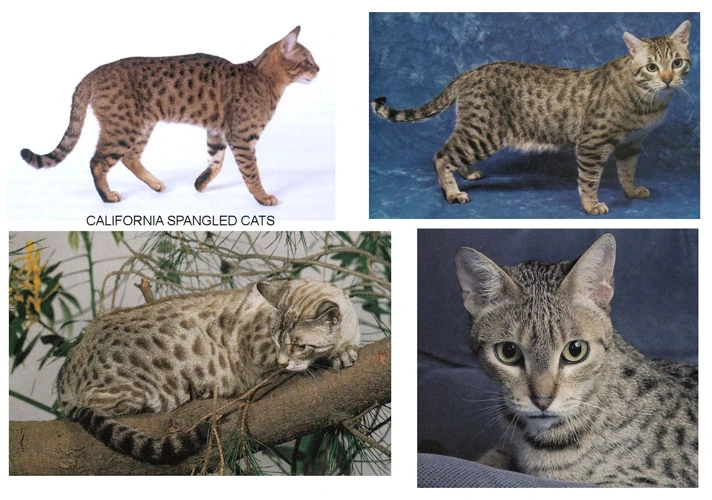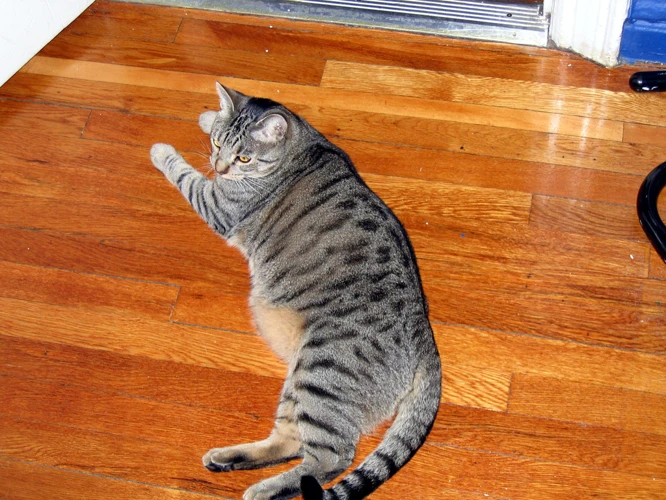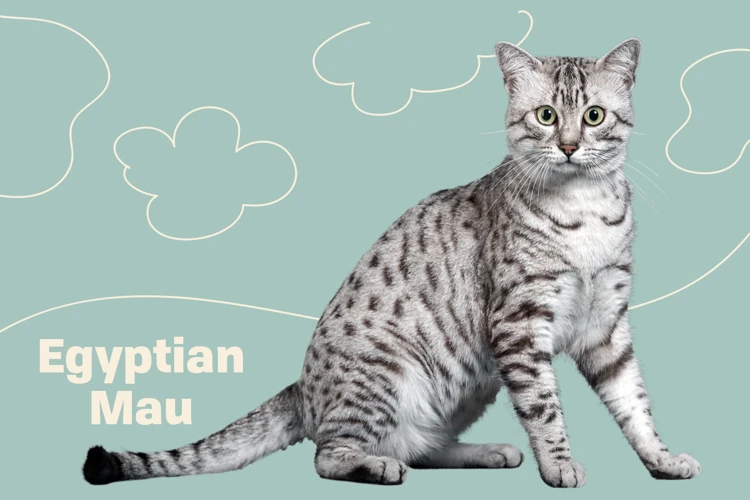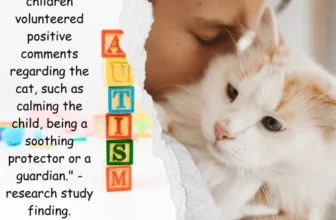Have you ever noticed your California Spangled Cat becoming unusually possessive of their territory? Perhaps they hiss or scratch at other cats or animals, or even display aggression towards humans who intrude on their space. Understanding the territorial behavior of your feline friend is crucial to maintaining a happy and healthy household. In this article, we will explore the origins of territorial behavior, common triggers that may cause it to escalate, and techniques for preventing and dealing with territorial aggression in your California Spangled Cat. So, let’s dive deeper into the complex nature of feline territorialism.
What is territorial behavior?

Understanding the Territorial Behavior of California Spangled Cats
Before discussing the territorial behavior of California Spangled cats, it’s important to understand what territorial behavior is all about. Territorial behavior is a natural trait among animals, including cats, that involve marking and defending a specific area they consider as their own. In cats, this behavior can be exhibited in various ways, and identifying such behaviors is helpful in understanding their needs and ensuring that they’re happy and healthy. By learning more about territorial behavior in cats, pet owners can easily recognize common territorial actions exhibited by their feline companions. It helps cat owners prevent such behavior from becoming destructive, which can harm not only their pets but also their homes.
Why do cats act territorial?
When it comes to cats, territorial behavior is a natural instinct. Cats act territorial in order to defend their resources and feel safe in their environment. This behavior is deeply ingrained in their instincts which are rooted in survival and hunting. Here are some reasons why cats act territorial:
- Protection: Cats want to protect their resources such as food, water, and sleeping areas. They also want to protect their territory from intruders or other animals that may pose a threat to their safety.
- Mating: Unneutered cats may act more territorial during mating season to attract potential mates and defend their territory from other male cats.
- Survival: In the wild, cats must defend their territory in order to hunt and survive. Even though domesticated cats have all their needs provided for, their instincts still drive them to act territorially.
Understanding why cats act territorial can help you recognize the signs and take steps to prevent or address any issues that may arise from this behavior. For more information on California Spangled Cat’s territorial behavior, check out our article on California Spangled Cat’s destructive behavior and their unique personality traits.
What are the signs of territorial behavior?
Territorial behavior in cats can manifest in various forms, and recognizing the signs is crucial to understanding their behavior. Here are some common signs of territorial behavior to look out for:
| Signs of Territorial Behavior | Description |
| Urine marking | Male cats are more likely to display this behavior, but any cat can spray urine to mark its territory. The smell of urine conveys information to other cats about who lives in the area. |
| Scratching | Cats have scent glands in their paws, so scratching furniture or walls is a way to mark their territory. Scratches also serve as visual cues to other cats. |
| Aggression | When cats feel their territory is threatened, they may become aggressive towards other pets or even humans. This can include growling, hissing, or biting. |
| Fighting | Cats may engage in physical fights over territory, especially if there are multiple cats living in the same household. |
| Guarding | If a cat is territorial about their food, litter box, or sleeping area, they may become defensive or possessive of these resources. |
It’s important to note that some territorial behaviors in cats can easily be misconstrued as playful or curious behavior. For example, a cat may scratch at a new piece of furniture simply because it’s an interesting texture or climb a high shelf to get a better view of its surroundings. However, if these behaviors become obsessive or aggressive, they may indicate territorial issues that need to be addressed.
Understanding the signs of territorial behavior is just one step in understanding your cat’s behavior. To learn more about the environmental factors that can influence the territorial behavior of California Spangled cats, continue reading.
How can territorial behavior escalate?
Territorial behavior in cats can quickly escalate if not handled properly. One way that territorial behavior can escalate is through aggressive behavior. Cats may become more aggressive towards individuals or other animals that they perceive as a threat to their territory. This can lead to physical altercations, which can result in injuries to the cats or other pets in the household.
Another way territorial behavior can escalate is through marking behavior. Cats may begin to mark their territory excessively by urinating or defecating in inappropriate areas. This could be a sign that the cat is feeling threatened or stressed, and is trying to reassert their dominance in the household. Marking behavior can also be a sign of underlying health issues, so it is important to rule out any underlying medical conditions before addressing the territorial behavior.
Lastly, territorial behavior can escalate when cats feel their resources are being threatened. These resources could include food, water, litter boxes, or even climbing space for California Spangled Cats to climb. Cats may become increasingly possessive of these resources, leading to aggressive or defensive behaviors. It is important to ensure that each cat in a household has their own resources to prevent conflicts.
To prevent territorial behavior from escalating, it is important to address the underlying causes and provide adequate resources for each cat in the household. Additionally, gradual introductions to new cats or animals can help prevent aggression and territorial behavior. Providing adequate climbing space for California Spangled Cats to climb can also help alleviate stress and prevent conflicts. By addressing territorial behavior early on, pet owners can prevent more serious problems from developing.
For more information on California Spangled Cats’ territorial behaviors, please see our article on California Spangled Cat Health and Behavior.
California Spangled Cats’ Territorial Behaviors

As a breed that has been selectively bred from wild species to produce a feline that enjoys human company as well as some of its natural instincts, California Spangled Cats develop individual territorial behaviors that can vary from cat to cat. It’s important to understand the typical territorial patterns of California Spangled Cats so that owners can avoid certain situations that could provoke territorial aggression. Let’s delve into the various territorial behaviors of this unique breed and how understanding them can help prevent potential conflicts in multi-feline households or homes with small children.
Origins of the California Spangled breed and how it influences their behavior
The California Spangled breed was developed in the 1980s by a cat lover named Paul Casey. He aimed to create a cat breed that resembled wild cats like leopards and ocelots, but without using any wild genetics. Casey bred together different breeds, such as the British Shorthair, Siamese, and American Shorthair, to achieve this unique look.
The California Spangled cat’s wild appearance can influence their behavior. They may exhibit traits similar to their wild counterparts, including territorial behavior. This breed’s natural inclination towards hunting and climbing may also result in high energy levels and a need for ample play and exercise. California Spangled cats require plenty of climbing space, so providing cat trees and shelves is important for their overall well-being and happiness. Regular playtime and interactive toys can also prevent destructive behavior and keep their energy levels in check.
On the other hand, California Spangled cats are also known to be affectionate and social with their human family. They crave attention and interaction, so it’s important to provide them with ample socialization and playtime. When properly socialized, they can get along with children and other pets in the household. For more information on California Spangled cats and children, check out our guide to raising California Spangled cats with kids.
The California Spangled cat’s unique appearance and personality make them a beloved breed among cat lovers. However, it’s important to understand their specific needs and tendencies to provide them with a happy and healthy life. For more tips on how to prevent territorial behavior in California Spangled cats, check out our guide to calming territorial aggression. Additionally, providing them with enough climbing space is crucial for their wellbeing, so don’t miss out on our guide to why California Spangled cats need climbing space.
Common territorial behaviors of California Spangled cats
California Spangled cats are known for their territorial behavior. Below are some common territorial behaviors that these cats exhibit:
| Spraying | Male California Spangled cats have a tendency to spray urine to mark their territory. This is a distinct behavior from litter box training, and can be a difficult habit to break once it starts. |
|---|---|
| Scratching | Another common territorial behavior of California Spangled cats is scratching. They will scratch objects such as furniture, curtains, and rugs to mark their territory, which can cause a lot of damage. |
| Aggression | When California Spangled cats feel threatened or their territory is invaded, they may become aggressive. This can include hissing, spitting, and even attacking other animals or humans. |
| Guarding resources | California Spangled cats may guard their resources, such as food and water bowls, toys, and even sleeping spots. This behavior can be a sign of territorial aggression and it’s important to ensure that each cat in the household has adequate resources to avoid competition. |
| Unwillingness to share space | California Spangled cats may be unwilling to share space with other cats or animals. They may become territorial and territorial aggression can lead to fights and harm to the animal involved. |
It’s important for owners to understand and recognize these common territorial behaviors in California Spangled cats, to help ensure a safe and happy living environment for both the cats and humans in the household.
When do California Spangled cats act most territorial?
California Spangled cats are known for their fascinating territorial behavior. However, there are certain times when this behavior is more prominent than others. Understanding when California Spangled cats act most territorial can help us identify potential triggers and take steps to prevent any escalation of their behavior.
The following table outlines when California Spangled cats are most likely to act territorial:
| Time | Reason for territorial behavior |
|---|---|
| Mating season | During the breeding season, male California Spangled cats may become territorial in order to protect their mates from other males. They will often mark their territory with their scent and may become more aggressive towards other cats. |
| Introducing a new cat | When a new cat is introduced into the home, it can be a trigger for territorial behavior in California Spangled cats. They may feel threatened by the presence of another cat and attempt to protect their territory by marking it with their scent. This can lead to aggressive behavior towards the new cat or even their human family members. |
| Changes to their environment | California Spangled cats can become territorial if there are changes to their environment. For example, if furniture is rearranged or if a new piece of furniture is added, they may feel the need to assert dominance over the change by marking it with their scent. They may also become territorial if they feel their physical space is being invaded or if they perceive a threat. |
As we can see from the table, there are several reasons why California Spangled cats may act most territorial. It is important for cat owners to be aware of these triggers and take steps to prevent escalation of their cat’s territorial behavior. By providing enough resources for each cat, gradually introducing new cats to the household, and socializing kittens and adult cats, we can promote a peaceful and harmonious environment for both our feline friends and ourselves.
Common Triggers of Territorial Behavior

As cat owners, we all want our feline friends to be happy and comfortable in their environments. However, a common issue that can arise is territorial behavior. So, what triggers this behavior? It can be perplexing to understand why our cats suddenly become possessive or aggressive, but there are several common factors that can contribute to territorial behavior. By identifying these triggers, we can work to prevent them and ensure our cats feel secure and content in their homes. Let’s explore some of these triggers in more detail.
Changes in the environment
Cats are known to be highly sensitive to changes in their environment and any alteration in their established routine can trigger territorial behavior. These changes may be as minor as a new piece of furniture in the room or as drastic as a new family member or pet. Let’s take a look at some of the environmental changes that could lead to territorial behavior in California Spangled cats.
| Environmental Change | Effect on Territorial Behavior |
|---|---|
| Change in living space or territory | When a new cat or animal is introduced to their living space, it can make California Spangled cats feel threatened and uncomfortable, leading to territorial aggression. Even something as small as a rearrangement of furniture can trigger territorial behavior. |
| Change in daily routine | Any alteration in the daily routine of California Spangled cats can cause them to feel more anxious and stressed, leading to territorial behavior from them. This includes changes in feeding schedules or litter box area or any other changes in their normal routine. |
| New smells or scents | Cats have a highly developed sense of smell, and when they are exposed to new scents and smells, it can cause them to react with territorial behavior. This includes everything from new perfume to the smell of a new pet in the house. |
| New people or pets in the household | Adding a new family member or pet to the household can be a major source of stress for California Spangled cats, who may feel their territory is being threatened. This might include a new baby, a new pet, or a new roommate. |
It is vital to be aware of these environmental triggers for territorial behavior in California Spangled cats, and take appropriate steps to manage them. By limiting changes to their routine and introducing new elements in their environment in a gradual and controlled manner, pet owners can help ease the transition and prevent territorial behavior from escalating.
Presence of other cats or animals
When it comes to territorial behavior in cats, the presence of other cats or animals in the environment can be a major trigger. Cats are known for their solitary nature, and even those who are accustomed to living with humans can become defensive and territorial when other cats or animals come into their space. Here are some things to keep in mind when it comes to managing territorial behavior triggered by the presence of other animals:
- Introduce cats gradually: If you’re planning to bring a new cat into the household, it’s important to introduce the cats gradually to minimize the risk of territorial aggression. Start by keeping the cats separated in different rooms, and gradually allow them to become more familiar with each other’s scent and sound before allowing them to meet face to face.
- Provide separate resources: Make sure each cat in the household has their own food, water, litter box, and scratching post to minimize competition and territorial disputes. This is especially important in multi-cat households.
- Minimize competition: Try to minimize competition by making sure there are enough resources for each cat. This may mean providing extra litter boxes or feeding cats in different rooms.
- Use pheromone products: There are a variety of pheromone products on the market that can help to calm cats and reduce territorial behavior. These products can include sprays, diffusers, and collars.
- Supervise interactions: If you’re introducing cats or other animals to each other, make sure to supervise their interactions closely. If one cat becomes aggressive or territorial, try separating them and allowing them to calm down before reintroducing them.
By taking steps to minimize competition and aggression between cats and other animals in the household, you can help reduce the occurrence of territorial behavior and ensure a more peaceful coexistence among pets. However, it’s important to remember that some cats may always be more territorial than others, and seeking the advice of a professional animal behaviorist may be necessary in extreme cases.
Lack of socialization
Cats that are not properly socialized may display territorial behavior as they may not know how to interact with other cats or animals. Socialization is the process of introducing cats to different people, animals and environments to help them develop positive associations with them.
A lack of socialization can cause a cat to become fearful of new people, animals or environments. Fear can lead to aggression when a cat feels threatened or uncomfortable. This may result in the cat displaying territorial behavior towards other pets or people who come into their space.
It is important to socialize kittens from a young age to help them develop good social skills. This can include exposing them to different environments and people, and playing with them regularly. Adult cats that have not been socialized may require more time and patience to overcome their fears and negative associations.
To help a cat become more socialized, consider using a reward-based approach. This can involve providing treats or rewards when the cat is exposed to new people or animals without displaying aggressive behavior. It is important to ensure the cat feels safe and comfortable during these interactions.
Providing the cat with plenty of enrichment activities and toys can help to reduce territorial behavior. This can include scratching posts, toys that dispense treats, and interactive toys that provide mental stimulation.
A lack of socialization can contribute to territorial behavior in cats. By providing them with positive experiences and gradual exposure to different situations, owners can help reduce the likelihood of aggressive behavior in their pets.
| Causes of Lack of Socialization | Solutions for Socializing |
|---|---|
| Isolation from contact with people or other pets | Slowly introduce the cat to new people or other cats with positive reinforcement |
| Previous negative experiences with people or animals | Provide positive experiences and gradual exposure to different situations |
| Restrictive living environment where cat is not exposed to new stimuli | Provide toys and enrichment activities that simulate natural environments |
Preventing Territorial Behavior

As cat owners, we want our feline friends to be happy and content in their home environment. One important aspect of achieving this is preventing territorial behavior. Territorial behavior can manifest in a variety of ways, from inappropriate marking to aggressive behavior towards other pets or humans. Fortunately, there are steps you can take to prevent territorial behavior from developing in the first place. By providing adequate resources, introducing new pets gradually, and socializing your cats early on, you can help create a harmonious home for your beloved California Spangled cats. Let’s dive into the details of each of these strategies and how they can benefit your cat’s overall well-being.
Providing adequate resources for each cat in the household
When it comes to preventing territorial behavior among California Spangled cats, providing adequate resources for each cat in the household is crucial. This means making sure that each cat has their own food and water bowls, litter box, and individual space for play and sleep. Here are some tips to ensure that each of your cats have their own resources:
- Separate food and water bowls: Cats can become territorial when they feel like they have to compete for resources. By providing separate food and water bowls for each cat, you can eliminate any competition over food and water.
- Multiple litter boxes: As a general rule, it’s recommended to have one litter box per cat plus an extra one. This gives each cat their own place to go to the bathroom and helps reduce stress caused by sharing a litter box.
- Individual play and sleep areas: Make sure that each cat has their own bed or blanket to sleep on and their own toys to play with. Cats may become territorial over their sleeping or play areas, so providing individual resources can help prevent this.
By providing adequate resources for each cat in your household, you can prevent competition over resources and reduce the likelihood of territorial behavior.
Gradual introductions to new cats or animals
Introducing a new cat or animal to the household can be a delicate process, especially if you already have a California Spangled cat displaying territorial behaviors. It’s essential to make this experience as smooth and stress-free as possible for all parties involved. This can be achieved with gradual introductions, which allow your cats to get used to each other’s smells and presence.
Step-by-step guide to gradual introductions:
| Step | Description |
|---|---|
| Step 1: Isolate the new cat | Before starting the introductions, make sure to isolate the new cat or animal in a separate room, with their own litter box, food, and water. This will allow your cats to get used to the new smells gradually. |
| Step 2: Scent swap | This step involves exchanging bedding or towels between your cats and the new cat. This will allow the cats to get used to each other’s scents gradually. |
| Step 3: Visual introductions | After a few days of scent swapping, you can allow your cats to see each other through a glass door or baby gate. This will help them get used to seeing the new cat without the risk of direct contact. |
| Step 4: Controlled face-to-face meetings | Once your cats seem comfortable with each other’s presence, you can start introducing them face-to-face while under your close supervision. Keep the initial meetings short, and gradually increase the time as they become more comfortable with one another. |
| Step 5: Full integration | After several successful controlled meetings, you can start allowing your cats to spend time together without supervision. However, it’s still crucial to keep an eye on them to ensure there are no aggressive outbursts or territorial behavior. |
Remember that each cat is unique and may take longer to adjust to a new cat or animal in the household. Be patient and take things slow to make the integration process as smooth as possible.
Socializing kittens and adult cats
Socializing kittens and adult cats is an essential aspect of preventing territorial behavior in cats, regardless of breed. Here are some tips for socializing your California Spangled cat:
- Start early: If you have a California Spangled kitten, it’s important to start socializing them as early as possible. Expose them to different people, environments, and other animals so they can learn to feel comfortable in various situations.
- Provide positive experiences: When introducing your California Spangled cat to new environments or animals, make sure they have a positive experience. Use treats and playtime to reinforce positive behavior and reward them when they display non-aggressive behavior.
- Gradual introductions: When introducing a new cat to your household, make sure to do so gradually. Keep the new cat in a separate room for a few days, and swap out bedding so they can get used to each other’s scent. Gradually increase their interactions under supervision until they can coexist without issue.
- Enrichment activities: Providing enrichment activities such as puzzle toys and scratching posts can help reduce stress and prevent territorial behavior. These activities encourage mental stimulation and help your cat feel more comfortable in their environment.
- Stay calm: Cats can be very sensitive to their owner’s emotions. Stay calm and relaxed when introducing your California Spangled cat to new situations and other animals. If you’re feeling stressed or anxious, your cat is more likely to feel the same way.
By socializing your California Spangled cat and providing them with positive experiences, you can reduce their likelihood of displaying territorial behavior. Remember to stay patient and consistent in your interactions with your cat to establish a strong bond and a positive relationship.
Dealing with Territorial Aggression
Finding ways to deal with territorial aggression in cats can be a perplexing and nerve-wracking experience for cat owners. It can be worrisome to witness a beloved pet exhibiting aggressive behavior towards other cats or humans. However, it is important to remember that territorial aggression is a natural instinct for cats, and it can be managed with the right techniques. In this section, we will explore some effective strategies to deal with territorial aggression in California Spangled cats, including when to seek professional help and the use of calming techniques and positive reinforcement training. Let’s dive in!
When to seek professional help
It can be difficult to know when to seek professional help in dealing with your California Spangled cat’s territorial aggression. Here are some signs that you may need to consult with a veterinarian or animal behaviorist:
- Physical harm: If your cat’s aggression is causing physical harm to both you and other animals in the household, it’s important to seek help immediately. Scratches, bites, and injuries can be serious and can even lead to infections.
- Unpredictable behavior: If your cat starts displaying unpredictable behavior, such as attacking without warning, it may be a sign of a more serious issue.
- Excessive vocalization: Cats may hiss or growl as a warning sign, but if the vocalization is excessive or prolonged, it may indicate a need for help.
- Changes in appetite or behavior: A change in your cat’s appetite or behavior, such as excessive sleep or lethargy, could be a sign of a more serious underlying medical issue.
- Escalating aggression: If your cat’s territorial aggression is escalating despite your attempts to curb the behavior, it may be time to seek professional help.
If you notice any of these warning signs, it’s important to seek professional help as soon as possible. A veterinarian or animal behaviorist can help you determine the underlying cause of your cat’s territorial behavior and develop a treatment plan to help manage the aggression. Remember, seeking professional help is not a sign of failure but rather a responsible way to ensure the safety and well-being of both you and your beloved California Spangled cat.
Introducing calming techniques and products
When dealing with a California Spangled cat that displays territorial aggression, introducing calming techniques and products can be helpful in reducing their stress levels and decreasing the chances of them exhibiting aggressive behavior. Some calming techniques that can be used include:
- Play Therapy: All cats enjoy playing, and play therapy can be used to distract your cat from aggressive behavior. Play with them regularly using interactive toys such as fishing wands, laser pointers, or puzzle feeders. This will help your cat expend pent-up energy and stimulate their mind, reducing anxiety levels.
- Environmental Enrichment: Environmental enrichment is a process of making the living space for your cat more interesting. California Spangled cats like to have access to high places, such as cat trees, where they can observe their surroundings from a safe distance. By adding various types of toys, scratching posts, and cozy hiding places around the house, you can stimulate your cat’s senses and create a more comfortable and inviting living space for them.
In addition to the above, there are also several calming products available on the market that can help reduce anxiety in cats, including pheromone diffusers, herbal supplements, and prescription medications.
It is essential to remember that not all calming techniques and products will work for every cat. What works for one may not work for another. It may take some trial and error to find the right combination of products and techniques that work best for your California Spangled cat.
Using positive reinforcement training to modify behavior
Positive reinforcement training can be an effective way to modify your California Spangled Cat’s territorial behavior. This method involves rewarding good behavior to encourage it to happen again in the future. However, it’s important to note that this training technique requires patience and consistency.
One way to implement positive reinforcement training is by using treats to reward your cat when they display non-aggressive behavior towards other cats or animals. For example, when your cat sees another animal and remains calm, reward them with a treat. This will encourage them to continue this behavior in the future.
Another way to use positive reinforcement training is by giving your cat attention and affection when they exhibit desirable behavior. Praise them when they are calm around other animals or when they use their scratching post instead of furniture.
To properly implement positive reinforcement training, it’s essential to be consistent and timely with the rewards. Use a consistent reward, such as a special treat, and deliver it immediately after the desired behavior occurs. This will help your cat make the connection between their behavior and the reward.
It’s also important to note that negative reinforcement, such as scolding or punishment, is not an effective method of modifying behavior. This can actually increase your cat’s aggression and worsen their territorial behavior.
Below is a table summarizing the key points of using positive reinforcement training to modify territorial behavior in California Spangled cats:
| Method | Description |
| Treats | Rewarding non-aggressive behavior towards other cats or animals with treats |
| Affection | Praising and giving attention when exhibiting desirable behavior |
| Consistency | Consistently rewarding behavior with a special treat or attention |
| Timing | Delivering rewards immediately after the desired behavior occurs to help make the connection |
| Negative reinforcement | Avoiding scolding or punishment, as this can increase aggressiveness |
Using positive reinforcement training can be an effective way to modify your California Spangled Cat’s territorial behavior. By rewarding desirable behavior, you can encourage your cat to be less aggressive and more accepting of other cats and animals in their environment.
Conclusion
After understanding the territorial behavior of California Spangled cats, it is important to be proactive in preventing and managing any potential issues. Providing adequate resources for each cat in the household and ensuring gradual introductions to new cats or animals can greatly decrease the likelihood of territorial behavior. Socializing kittens and adult cats can also help to mitigate territorial tendencies.
If territorial aggression does occur, it is important to seek professional help and consider introducing calming techniques or products. Positive reinforcement training can also be an effective way to modify behavior.
It is important to keep in mind that territorial behavior is a natural instinct for cats, and cannot be fully eliminated. However, by understanding the triggers and signs of territorial behavior, and taking proactive steps to prevent escalation, we can provide a safe and comfortable environment for both our California Spangled cats and ourselves.
Frequently Asked Questions
What is unique about the California Spangled cat’s territorial behavior?
The California Spangled cat’s territorial behavior is unique in the sense that they tend to establish and guard larger territories compared to other domestic cat breeds.
How can you tell if a cat is exhibiting territorial behavior?
Cats exhibiting territorial behavior will typically display signs such as hissing, growling, urine spraying, scratching, and aggressive behavior towards other cats or animals that enter their space.
Can territorial behavior in cats be prevented?
While it is difficult to completely prevent territorial behavior in cats, there are methods that can be employed to subdue and manage aggressive behavior among them.
Are California Spangled cats more aggressive than other cat breeds?
Not necessarily. While they may display more pronounced territorial behavior, this does not necessarily equate to higher levels of aggression compared to other cat breeds.
What is the best way to introduce a new cat into a household with existing cats?
Gradual introductions between new cats and existing cats in the household is recommended. This can be done by exchanging items with the scent of each cat, creating safe spaces for each cat, and supervised interactions.
Can a cat’s past experiences influence its territorial behavior?
Yes. A cat’s past experiences, particularly those related to conflict with other cats, can influence their territorial behavior in the future.
Can neutering or spaying a cat help with territorial behavior?
Neutering or spaying a cat can often help to reduce territorial behavior, particularly in male cats.
At what age should kittens be socialized to prevent territorial behavior?
Kittens should be socialized as early as possible, ideally between the ages of 2-7 weeks. However, socialization can still be achieved in adult cats, but it may require more effort and patience.
When should a cat owner seek professional help for territorial behavior?
A cat owner should seek professional help if their cat’s territorial behavior is extreme, persistent, and affecting the overall well-being of the cat and other cats in the household.
Can aggressive behavior in cats be corrected through positive reinforcement training?
Positive reinforcement training can effectively modify aggressive behavior in cats if consistently practiced and if the root cause of the behavior is identified and addressed.







